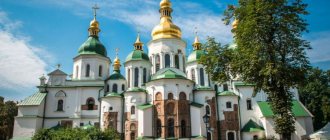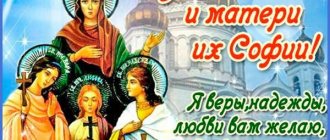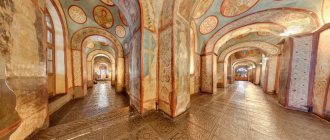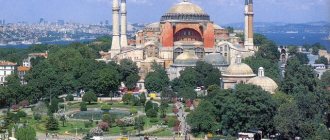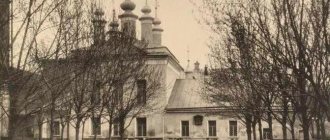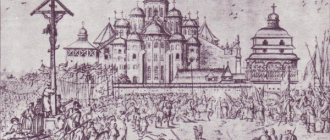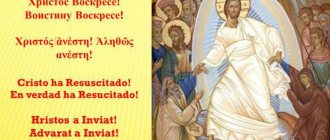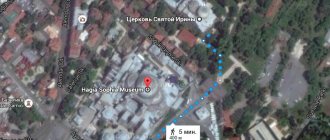Orthodox Life
The complex of mosaics of St. Sophia of Kiev is a unique work of its kind, since it is the only mosaic ensemble of Kievan Rus that has survived to such a significant extent to our time (the mosaics of the cathedral church of the St. Michael's Golden-Domed Monastery in Kiev have partially survived - the temple itself was destroyed in the 30s of the XX centuries, the mosaics of the Tithe Church have not survived at all - only individual pieces of smalt have reached us).
St. Sophia Cathedral in Kyiv
Built in the first half of the 11th century, the Cathedral of St. Sophia was conceived as the place of the metropolitan see (by the way, it is appropriate to remember that the chronicle nickname of Kiev - “mother of Russian cities” - is a literal copy from the Greek language: “mother of cities” - metropolis) and, accordingly, as the largest and most luxurious temple of Rus'.
Saint Sophia Cathedral. Interior
The huge five-nave, thirteen-domed cathedral was created by Byzantine masters, but, interestingly, we do not find direct analogues of Sophia of Kyiv in the Byzantine architecture of that period.
The interior decoration is also distinguished, primarily by a mixture of techniques - mosaics and fresco painting (in Byzantium, as a rule, churches were painted either with paints or with mosaics). But Rus' in the 11th century was the cultural periphery of the Byzantine world, and mosaics were very expensive (not counting the costs of transporting the materials themselves). Therefore, a compromise decision was made: the key parts of the temple (altar, dome, pre-altar pillars and dome arches) were decorated with mosaics, and the rest of the temple space was painted.
The mosaics of Sophia of Kyiv belong to the late Macedonian style. The Macedonian style (Macedonian Renaissance) is the general name for Byzantine art during the reign of the Macedonian imperial dynasty (867–1056). This was a period of global revival of church art after the iconoclastic persecution. At the beginning of the Macedonian period, classical ancient forms of painting were strong, but by the 11th century the trends had changed. During this period there is a turning point towards greater severity and asceticism. The forms freeze, the figures of the saints acquire severity, immobility, and symmetry. It is assumed that such transformations of the Macedonian style are associated with the influence of monastic internal “interior” aesthetics, which at the beginning of the 11th century became, if not dominant, then very influential. And it was precisely during this period that the activity of such a great representative of the aesthetics of asceticism as St. Simeon the New Theologian (+1022). This strict, ascetic-oriented, intensely spiritual style is fully manifested in the mosaics of Kyiv Sofia.
When we enter the St. Sophia Cathedral, the first thing that opens to our eyes is the majestic image of the Virgin Mary, 5.45 meters high, in the altar apse. The concave surface of the apse itself reflects light in such a way that it creates the illusion of a golden background shining around the figure of the Mother of God. This is further emphasized by smalt cubes, which are inserted into the background plaster at different angles.
Fragmented smalt mosaics of St. Sophia of Kyiv
The color palette of Kiev-Sofia mosaics is quite rich, for example, the blue color has 21 shades, green – 34, etc. Even the gold backgrounds are heterogeneous, the gold color has 25 shades. In total, the mosaics of St. Sophia Cathedral have 177 shades of different colors.
The Mother of God is depicted praying with her hands raised up; this ancient gesture of prayer is depicted in the paintings of the early Christian catacombs. Based on this gesture, the Mother of God image of St. Sophia Cathedral is often called Oranta, that is, praying. This image is also called the “Unbreakable Wall”. This phrase, originally borrowed from the 12th ikos of the akathist to the Most Holy Theotokos “Rejoice, indestructible wall of the kingdom,” over time acquired a literal interpretation among the people. Indeed, over all the centuries of the cathedral’s existence, despite many devastations, the wall with this image was never destroyed. That’s why the belief arose that Orthodox Kyiv would stand as long as the Lady of God praying was in the St. Sophia Cathedral with her hands raised...
Along the perimeter of the apse arc there is a Greek inscription, which once again emphasizes the intercession of the Mother of God: “ὁ Θεὸς ἐν μέσῳ αὐτῆς καὶ οὐ σαλευθήσεται·βοηθήσει αὐ “God is in the midst of her and does not move: God will help her in the morning” (Ps. 45:6).
The wide-open eyes of the Mother of God, her calm, detached gaze, large facial features - all these are signs of a new ascetic style. Her hands are raised up - to where the Almighty Christ is depicted in the dome.
The image of Christ Pantocrator - the Pantocrator is executed in the same strict manner, in the same laconic language characteristic of the late Macedonian style.
A round shield with a diameter of 4.1 m with the image of the Savior in the dome is surrounded by four archangels in rich Byzantine ceremonial robes. Just as earthly courtiers surround the earthly emperor, angels surround the Heavenly King. Each of them holds symbols of supreme power: an orb and a long staff - labarum, which is crowned with a panel with the Greek inscription: “άγιος, άγιος, άγιος - Holy, Holy, Holy.” This reminds us of the Holy Scripture, which speaks of the seraphim surrounding the heavenly Throne: “And they called to each other and said: Holy, Holy, Holy is the Lord of Hosts! the whole earth is full of His glory!” (Isa. 6:3), and these same words are part of the liturgical Cherubic song.
The caesuras between the figures of angels, filled with a golden background, form a golden cross in the dome (it must be said that the theme of the combination of a cross and a circle is repeated several times in the interior decoration of St. Sophia of Kyiv).
Unlike the “unbreakable” apse wall, the dome of St. Sophia of Kyiv was seriously damaged. Of the four archangels, only one has survived - in a blue robe. The remaining three were painted in 1884 in oil paints by the outstanding artist M.A. Vrubel, who, using strokes, tried to imitate a mosaic surface and quite accurately reproduced the style of the images.
Just like the dome, the drum, where the images of the twelve apostles were located in the walls of the twelve windows, was significantly damaged. Only one image has survived (and only partially, waist-deep) - that of the Apostle Paul.
Under the dome, in the sails, there were images of the four evangelists. Surprisingly, as in the case of the apostles and archangels, only one of these images has survived to this day - the Apostle Mark. It can be noted here that photographs taken from the dome itself convey many images in a “distorted” form, because these images were originally designed for the viewer located below, for which Byzantine masters used special perspective distortions.
The figure of John the Evangelist has been partially preserved (legs and arms).
A very small fragment (a desk) remains from the image of the Apostle Matthew...
If you draw a mental line from the praying Mother of God to the Pantocrator in the dome, you can see that Christ is depicted three times on this axis: the Pantocrator in the dome itself, Christ the priest at the level of the evangelists and below - in the arch, directly above Oranta in the Deisis scene.
Christ the Priest presents us with a rather rare iconographic type, of which very few examples have survived. Here the Savior is depicted in His traditional, and not in priestly attire. And His priesthood is indicated only by the hairstyle adopted by the clergy of that period - a cropped crown, the so-called. humenzo (in the Russian Church this type of hairstyle was preserved until the middle of the 17th century, and in the Roman Catholic Church it took place literally until recently (“tonsure”) until abolition by Pope Paul VI in 1973).
Deisis (in Greek - prayer). Once again it reminds us of the intercession of the Mother of God and the saints before the Savior for Christians.
In the center of the composition is Christ in a traditional image. And on either side of him is the “most honorable of the cherubim” and “the most glorious of the seraphim” the Mother of God and “the greatest of those born of women” John the Baptist - the main prayer books for the Christian race.
In the Altar, below the Mother of God Oranta, in two-level registers there are images of the Communion of the Apostles and below - the hierarchical rite.
In the Communion scene, the Altar is depicted in the center with liturgical paraphernalia on it and a canopy above it. Around the Throne stand angels in the form of deacons in surplices with ripids.
On the sides of the Throne we see the Savior depicted twice, who from His hands gives communion to the apostles (six on each side), on the one hand - the Body, on the other - the Blood.
The location of this composition precisely in the center of the Altar is not typical of the Byzantine tradition itself. There is an opinion that in this way in Rus', which adopted Christianity from Byzantium, it was the Eastern tradition of communion of two types that was emphasized, in contrast to the tradition that had taken place by that time in the West, even before the fall of Rome, of giving communion to the laity only of the Body.
Below the Apostolic Eucharist is the “hierarchal rite” - an image of a group of saints - holy bishops, among whom we see miracle workers, martyrs and teachers of the Church. But among the holy bishops there are also two holy deacons: Stephen and Lawrence.
The lower part of these images was also significantly damaged and was later painted over.
Holy rite. John Chrysostom
Gregory the Wonderworker
Clement, Pope
Archdeacon Lavrenty
General view of the main dome of Hagia Sophia with supporting arches
The four arches supporting the dome are decorated with medallions with images of the forty martyrs of Sebaste (15 such medallions have survived to this day: 10 on the southern arch and 5 on the northern). The martyr images located in the arches supporting the vault were probably meant to remind that the Church was built on the blood of martyrs.
Each of the martyrs holds a cross in one hand, as a symbol of his suffering, and in the other, a crown, as a symbol of heavenly reward.
Combined image of the Annunciation scene on the pre-altar pillars
On the pillars located around the altar apse, there is an image of the Annunciation of the Blessed Virgin Mary - the beginning of New Testament history. On one pillar is the Archangel Gabriel, whose image is accompanied by a greeting written in Greek: “Rejoice, full of grace...”, on the other is the Mother of God herself. Nearby is a Greek inscription: “Behold the handmaid of the Lord...”
From other mosaics reminiscent of the Old Testament, only the image of the high priest Aaron, located on the inner pre-altar arch, has survived.
Mosaic ornaments of Sophia of Kyiv. Decoration of the back of the throne of the Kyiv Metropolitans
Many ornaments have also been preserved, which, where necessary, shade or emphasize the main images.
The mosaics of Sophia of Kyiv embodied the results of the development of the Macedonian style of Byzantine art. Their strict, restrained, inward-directed beauty raised the thoughts of ancient Russian Christians to Divine truths, the image of which Christian icons are called to be. This beauty, even now, almost nine centuries later, continues to reveal these truths to our contemporaries.
Dmitry Marchenko
Literature: Lazarev V. N. Old Russian mosaics and frescoes of the 11th–15th centuries. M.: Art, 1973. National Nature Reserve “Sofia Kievska”. K.: Baltiya-Druk, 2011. Bychkov V.V. Small history of Byzantine aesthetics. K.: Path to Truth, 1991. Kolpakova G. S. The Art of Byzantium. Early and middle periods. St. Petersburg: ABC-classics, 2010. History of icon painting of the 6th–20th centuries. M.: Art-BMB, 2002. Sarabyanov V.D., Smirnova E.S. History of Old Russian painting. M.: PSTGU, 2007.
See also: Graffiti of Sofia of Kyiv. Memory of Ancient Rus'
Interior design and architecture
During the reign of Yaroslav the Wise, an outstanding architectural monument was built in Kyiv - St. Sophia Cathedral. It was built by visiting Greek architects and local Russian craftsmen.
The interior design of the cathedral cannot help but charm - magnificent mosaics, frescoes, carved slate tiles, the marble tomb of Yaroslav the Wise, forged and gilded doors, cornices, column capitals.
Sophia of Kiev has survived to this day in the style of Ukrainian Baroque of the 17th - 18th centuries. But the architectural basis and interior design have retained their original appearance.
Of the entire original quantity of mosaics, which reached 640 square meters, only 260 square meters remain today. The mosaic floors were completely destroyed, and part of the painting on the semicircular wall behind the altar crumbled. The floors, skillfully laid out from pieces of mosaic, died in the 19th century after a cast-iron slab was placed on them.
Many frescoes were damaged during repair and restoration work in 1848 - 1853. The artists - contractors Fokt, Zholtonozhsky, Polikonov - redrew the ancient images with oil paints at their own discretion.
The mosaics of Sophia of Kyiv are the pearl of world art. Upon careful examination of most paintings, one can determine that they are made in various individual manners. Of particular interest is the mosaic image of the archangel.
Archangel mosaic
The soil for the mosaic was prepared very carefully. The wall was covered with three layers of plaster, and on the top of them the artist painted one or another image or ornament with colored water paints. Thus, frescoes were painted on the walls depicting the evangelists - John, Mark and Matthew.
Evangelist Mark
Evangelist John
Evangelist Matthew
The color palette of Kyiv mosaics is one of those miracles that excites and never ceases to amaze. But the artist’s skill is manifested not only in colors. In the St. Sophia Cathedral, some mosaics are placed closer to the audience, others further away. Some are brighter lit, others are in less lit areas. Some mosaics are applied on flat planes, others on curved ones.
The mosaics of St. Sophia of Kyiv are generally characterized by harmony, not contrast. A certain attraction to contrasts is noticeable only in domed mosaics. Mary Oranta, Communion, the Holy Order, the Annunciation, as well as altar ornaments are executed in a smooth transition.
The central image that immediately attracts the attention of viewers is Maria Oranta , the Mother of God - intercessor and defender of Kiev. She is depicted in the main place in the temple. The entire background is lined with golden smalt.
Maria, with a serious, even stern face, seems truly indestructible and omnipotent. And the blue, light blue, gold, lilac and black colors in her clothes give her figure a solemn festivity.
The face of Maria-Oranta appears pinkish from afar. Her face comes alive, its expressiveness enhanced by the soulful gaze of her deep eyes. The glances of the saints are sometimes sad, sometimes pleading, sometimes filled with stern grandeur or tender love. But in all cases they are passionate, vigorous and lively. All this indicates that the artists deeply studied the inner world of man.
Maria Oranta
Over the thousand-year history of its existence, the mosaics of the Cathedral of St. Sophia of Kyiv have not lost a single shade of their original richness and richness of colors. They were and remain examples of the extraordinary power of art.
The mosaic “ Christ Pantocrator ” (Christ the Pantocrator) is located in the central dome of the St. Sophia Cathedral. This is one of the most important and most beautiful images, made by ancient artists with great skill.
St. Sophia Cathedral in Kyiv
The Temple of Sophia - the Wisdom of God this year celebrates the 990th anniversary of its foundation and the 970th anniversary of its consecration.
The temple is dedicated to Sophia - the Wisdom of God. It belongs to the works of Byzantine-Kyiv architecture. Saint Sophia is the main religious building of Kievan Rus during the times of Yaroslav the Wise (1019-1054).
There is no generally accepted dating for the construction of the church. The assertion that Yaroslav, who erected a temple in memory of the victory over the Pechenegs in 1036, acted as ktitor, has been repeatedly questioned. It was suggested that the cathedral was founded by Vladimir I Svyatoslavich, and the completion of construction and decoration of the building with frescoes and mosaics dates back to the reign of his son Yaroslav and occurred no later than the 1020s. However, this opinion has not become generally accepted. A. Poppe and A.I. Komech claim that the beginning of construction of the temple dates back to 1037.
In the "Novgorod First Chronicle" the foundation of the St. Sophia Cathedral by Prince Yaroslav is mentioned under the year 1017. However, the Tale of Bygone Years says: “In the summer of 6545 (1037). Found Yaroslav the great city, <...> also found the Church of St. Sophia, the metropolis.” The difference in dates may be explained by the entry in the Commission List of the Novgorod Chronicle: “... Yaroslav founded the city of Kiev, and completed the church of St. Sophia.” The cathedral was thus built between 1017 and 1037. In 1051, Hilarion, the first “Russian Metropolitan,” was already consecrated there.
However, there is no complete clarity on the question of which of the two churches - the Mother of God of the Tithes or St. Sophia - was the cathedral of the Kyiv metropolitans.
In the 1950-1960s, the scientific community established an opinion about two stages of construction of the cathedral. It was believed that the external galleries and towers were added to the general mass of the building at the end of the 11th century or even later. At present, it can be considered proven: the temple in its entirety was erected simultaneously without significant interruptions in construction.
Construction equipment and architectural features of the cathedral indicate that its builders were Greeks who came from Constantinople. They built the temple according to models and according to the traditions of metropolitan Byzantine architecture, albeit with some deviations.
The temple was built using the mixed masonry technique: rows of square bricks (plinths) alternate with rows of stones, and then covered with limestone coating - plaster.
Sophia was originally crowned with thirteen chapters, forming a pyramidal structure. Now the temple has 19 domes. In ancient times, the roof consisted of lead sheets laid on the vaults. At the corners the temple is reinforced with buttresses - vertical supports on the outside of the wall that take on its weight. The facades of the cathedral are characterized by an abundance of blades, which correspond to the internal division of space by supporting pillars. The outer walls of the galleries and apses are decorated with numerous niches.
On the western side, according to the Byzantine tradition, two staircase towers adjoin the temple, leading to the choir and flat roof - the walkway. During the service, the choirs were intended for the Grand Duke, his family and associates. However, they also had a secular purpose: here the prince, apparently, received ambassadors and discussed state affairs. The book collection of St. Sophia Cathedral was also kept here. Perhaps, in a separate room there was also a scriptorium - a workshop for copying books.
The interior of the cathedral was an equal-ended cross, with an altar apse in the east; there were two-tier arcades to the north, south and west. The central dome rose above the middle part of the cross. The main volume of the building was surrounded by two rows of open galleries.
The question of the interior decoration of the western part of the main nave acquires fundamental significance in connection with the study of the ktitor fresco depicting the family of Yaroslav the Wise, located on the western wall of the two-tier arcade.
Over the centuries, the church has undergone many changes. During the defeat of Kyiv by Batu in 1240, it was plundered. Subsequently, the temple burned down several times, gradually fell into disrepair, and was subjected to “repairs” and alterations.
In the 17th century, Sofia was “renovated” by Metropolitan Peter Mogila in the Ukrainian Baroque style and its appearance became very far from the original. The eastern facade with apses, where fragments of ancient masonry were cleared, survived best of all.
Verbal descriptions of Sofia created by foreign travelers of the 16th-17th centuries Erich Lyassota, Pavel Alepsky and others have been preserved, but the most important source for recreating the original forms of the building are the drawings of the Dutch artist Abraham van Westerfeld. He visited Kyiv in 1651 and made several sketches of the St. Sophia Cathedral and its paintings.
The interior of Sophia of Kyiv was less distorted and retained some of its original decoration. The earliest mosaics and frescoes have been preserved in the temple. They were also made by Byzantine masters. Scrawled inscriptions - graffiti - were found on the walls of the cathedral. About three hundred graffiti testify to political events of the past, they mention specific historical figures. The earliest inscriptions made it possible for researchers to clarify the dating of the interior decoration of the church.
Sofia became the burial place of the Kyiv princes. Yaroslav the Wise, his son Vsevolod, as well as the sons of the latter, Rostislav Vsevolodovich and Vladimir Monomakh, are buried here. The question of why members of the same family were buried in different churches - in Sofia and in Desyatinnaya - has not received a convincing answer from historians.
St. Sophia Cathedral was assigned the role of the main temple of Kievan Rus and the stronghold of the Christian faith. For several centuries, Sophia of Kiev was the center of all-Russian conciliarity and churchliness, the focus of the political and cultural life of the country.
Mosaics of Kyiv Sofia
The mosaic of “Savior Pantocrator” in the mirror of the central dome of St. Sophia of Kyiv is the most monumental image in the art of Rus' of the 11th century. The diameter of the medallion in which it is enclosed is more than four meters, the distance from the floor is 28.5 meters.
“Pantocrator” (Greek “Pantocrator” - omnipotent) is one of the main canonical types of depiction of Christ, where He is presented as the King of Heaven and Judge at the upcoming Last Judgment. The Son of God is depicted at the age of his preaching and in the clothes that he wore in his earthly life - in a tunic and himation. Christ sits on the throne, with his right hand he makes a blessing gesture, and with his left he holds a scroll or book with the law. If the book is open, the pages traditionally display various sayings of the Savior contained in the Gospels. The composition is distinguished by its strict frontality and static nature.
The spread of the canon of Christ the Heavenly King dates back to the time of the establishment of Christianity - to the 4th-6th centuries (the Ravenna mosaic without an inscription from the mid-6th century on the triumphal arch of the church of Sant'Apollinare in Classe is known). The formation of this iconographic image was influenced by the late Hellenistic tradition of depicting emperors.
The image of Pantocrator contains the idea of the Theanthropic dominion of Christ over the world. Calling Jesus Almighty indicates, on the one hand, His Divine nature: “I am Alpha and Omega, the beginning and the end, says the Lord, who is and who was and is to come, the Almighty” (Rev 1:8). On the other hand, such a naming is also connected with the human nature of Christ. Jesus becomes the Almighty by completing the second creation, atoning for human sins with the sacrifice of the cross and renewing human nature. God the Father, according to the Apostle Paul, “introduces the Firstborn into the universe” (Heb. 1:6).
Among the Sofia mosaics, “Savior Pantocrator” stands out for its enlarged forms and color contrast, so that the Heavenly King can be clearly seen by those who come to the temple.
The canon of “Christ the Pantocrator” is distributed in two editions: images are full-length and half-length. Throughout the Orthodox world, a half-length image of the Messiah is traditionally placed in the central dome. This tradition dates back, apparently, to the second half of the 9th century, from the time of the establishment of icon veneration in Byzantium. The domes of early Christian churches often housed the “Ascension.”
In its huge proportions and the manner of laying smalt, the figure of the archangel is close to the “Pantocrator” in the main dome and the “Our Lady of Oranthe” in the concha of Pantocrator and the “Archangel” to the same master, which is supported by the completely identical nature of the mosaic masonry in the faces. The head of “Oranta” is executed in a slightly different manner (a tighter fit of the cubes), but the squat proportion of this figure and the straight, heavy folds of the robe bring it closer to the images in the dome. Therefore, there are serious reasons to believe that the execution of the largest figures was entrusted to one master, whose specialty was working on large planes located at a considerable distance from the viewer’s eyes.”
The mosaics in St. Sophia of Kyiv were carried out by a master prone to large, monumental compositions. He created the image of Christ with a massive head, a short neck and rectangular shoulders. The Pantocrator, like the Byzantine basileus, wears a chiton of purple tones with gold trim and a red clave (sewn-on vertical stripe). Over the chiton is worn a blue cloak, the folds of which are lined with dark blue smalt and trimmed with gold assist (rays made of gold). The beard is almost completely lost - it was added with oil paint during the restoration. The medallion, consisting of nine multi-colored circles, is especially colorfully decorated. Apparently, this is a reminiscence of the rainbow on which Christ sat during the Ascension - this can be seen in the old iconography of the temple dome painting.
In the Kiev Cathedral, he also created the mosaic “Our Lady Oranta” in the conch of the central apse and, apparently, the “Archangel” in the dome space of the temple.
In the central dome of St. Sophia of Kyiv, the “Pantocrator” was surrounded by four archangels - like the ceremonial guard of the Byzantine emperor during a ceremonial exit. These are the archangels Michael, Gabriel, Raphael and Uriel. Of these, only one has survived; it is difficult to say which one, since there are no original inscriptions.
Archangels are the leaders of the angels; they constitute the highest degree of the angelic rank. They preach the gospel of the Great and Glorious (1 Thessalonians 4:16), reveal the secrets of God’s will, strengthen people’s faith and enlighten them with the light of the Holy Gospel.
The only “Archangel” from the mosaics of the St. Sophia Cathedral has not reached our time in full: there are losses in the wings, and the bottom of the clothes and legs were completed by Mikhail Vrubel.
The figure of the archangel is huge: its height is 3.85 meters. The archangel's proportions are squat, and he looks heavy and heavy. He is wearing the magnificent robes of a Byzantine emperor. He is dressed in a blue dalmatic - a narrow long robe made of thick fabric with wide sleeves, worn on a purple table - a long shirt, like a tunic, with narrow sleeves and cuffs. The shoulders and chest of the chief of angels are covered by a wide and long stripe strewn with pearls and precious stones. Red boots on her feet. Dalmatik, stola, lor, red shoes are attributes of the basileus’ attire and the iconic image of the archangels.
The archangel's wavy hair is tied with toroks (or in other words, rumors), meaning higher knowledge. Through torki, angels receive commands from God. In his right hand, the Archangel holds a mirror - a sphere on which is inscribed the cross installed on Calvary. The mirror is a symbol of the foresight that God conveyed to his angelic servant. In the mirror, the archangel also reads the commandments of the Lord. In his left hand, the archangel holds a labarum (banner) - a long shaft with a crossbar on which fabric is attached. On it is the Greek word "AGIOS", repeated three times: "Holy, Holy, Holy." The words are taken from the Revelation of John the Theologian: “Holy, holy, holy is the Lord God Almighty, who was, who is, and who is to come” (Rev 4:8). According to legend, the first church labarum - a standard with a cross - was erected by Constantine the Great in the battle with Maxentius.
On the eastern pillars of the girth arch are placed the Archangel Gabriel and the Mother of God, forming the composition “Annunciation”.
The description of the appearance of the Angel of the Lord to the Virgin Mary is present only in one Gospel - from Luke (Luke 1:26-39). On the basis of this plot, the iconography of the “Annunciation” was built, which is very diverse, rich in details and has several versions thanks to additions from numerous non-canonical sources.
On the Sofia mosaic, in the hands of the Virgin Mary there is a spindle with purple yarn, about which the Evangelist Luke says nothing. However, according to the apocryphal “Protoevangelium of James” (XI, 1), when the archangel appeared to the Most Pure Virgin with the news of the immaculate conception of the Savior of the world, She was spinning yarn for the veil of the Jerusalem Temple. “The Annunciation with Yarn” became one of the main iconography of this plot. It is this version of the “Annunciation” that is placed on the Royal Doors, which lead to the Holy of Holies - the altar. The mosaic does not contain any attributes of a specific location: this helps to indicate the hidden and mystical nature of the beginning of the Incarnation. Minimizing the set of “telling” details is a characteristic feature of Byzantine icon painting of the era of the Macedonian dynasty.
When laying out the image of the Mother of God, the Greek master skillfully used smalt of various shades of blue: the Virgin Mary wears a chiton of light blue tones, and the maforium is darker, with thick dark blue folds, reaching black. The face is lined with pinkish and white cubes, combined in shaded areas with greenish-gray ones. To the right of the Mother of God is a Greek quotation from the Gospel, the Russian translation of which: “[I am] the servant of the Lord, let it be done to me according to your word” (Luke 1:38).
Archangel Gabriel addressed to the Mother of God. With his right hand he blesses, and in his left, as the messenger of the Lord, he holds a staff. The inscription reads: “Archangel Gabriel: Rejoice, full of grace, the Lord is with you” (Luke 1:28).
The figures of the archangel and the Virgin Mary were made by different mosaic artists. Gabriel, unlike the Mother of God, is massive and heavy, and the folds of his robes are almost rectangular and brittle.
The mosaic of St. Sophia Cathedral is the earliest surviving “Annunciation” in ancient Russian art.
In the pictures: Hagia Sophia in Kyiv, eastern facade; reconstruction of the ancient appearance of the temple; tomb of Yaroslav the Wise in St. Sophia Cathedral; mosaics “Pantocrator”, “Archangel”, “Oranta”, “Annunciation”.
Prepared by Stanislav Minakov
according to publications of Ph.D. Yuri Pelevin on the Russian general education portal (www.school.edu.ru)
ORIGINS OF CHRISTIANITY
Made at the beginning of the 11th century by Byzantine masters, the mosaics of the Hagia Sophia Cathedral in Kyiv have always occupied the minds of art historians.
The most famous of them is the mosaic of Our Lady of Oranta from the Cathedral of St. Sophia in Kyiv, otherwise known as the “Virgin Mother of God - the Unbreakable Wall”.
The first thing that catches your eye is the volume of the image: the Mother of God seems to be protruding from a golden background. The thing is that Byzantine artists deliberately sought to ensure that the image seemed like this. The volume of the image was achieved using the following techniques:
- of course, this is a play of color: there are 177 shades in the mosaics of the cathedral; — pieces of smalt are in 3 levels; the mosaic was deliberately uneven, which creates a three-dimensional effect; - gold: the image of the Virgin Mary is on a gold background. Gold is extremely important in Byzantine art - both in mosaics and icons it symbolizes the Heavenly Jerusalem and the spiritual dimension; - a unique technique for producing the mosaic smalt pieces themselves. The effect of “Byzantine gold” was achieved using a complex technique: a gold or silver plate was placed inside the smalt so that the light penetrating through the transparent smalt was reflected from it at different angles.
This effect was not reproduced by later scribes. The Byzantine style was popular in the 19th century, and a large number of Italian masters were invited to the Russian Empire, who were considered experts in Byzantine mosaics, but for all their skill, their work differed significantly from the prototype. A completely different understanding of Byzantine mosaics is also demonstrated by the interiors of Western European churches of the neo-Byzantine style.
Just imagine, all these small gold smalt stones, of different colors and shapes, are placed at different angles. Obviously, this was done in order to create the effect of living light.
If you linger briefly in front of the Kyiv Mother of God Oranta, you will eventually see that the image is surrounded by a flickering radiance that is constantly changing.
It seems that the Mother of God is emitting this light.
And the golden space behind her is nothing other than the endless divine space. There is an opinion that the Greek masters deliberately created an image of the Mother of God, which seemed to appear in the space of the temple. The image here is not in the graphic plane, but in the space between the viewer and the representation - the boundary between the viewer and the image seems to be absent here.
The image of the Mother of God here goes out of the plane into the plane of communication with the observing person present in the church, if we speak in the language of art historians.
In their opinion, this is the fundamental principle of the Byzantine iconic image, as a spatial image that appeared in the post-iconoclastic period. And this principle is clearly demonstrated by the Kiev Mother of God Oranta.
By the way, this image is considered miraculous and a monastery was created in its honor in the south of Russia.
#origins_of Christianity #icons #icon #icon painting #miraculous_icons #mosaic #mosaics #Byzantium #iconography #pilgrimage
Painting of Kievan Rus - types, genres, canons of Sophia of Kievan
The origins of Russian painting, like other forms of art, lie in the distant 10th century. Then the Word of God triumphed on our lands: Kievan Rus adopted Christianity. And along with the new religion, the miraculous influence of Byzantine culture came to the largest state in Europe at that time. Temples were built as strongholds of Christianity and places of general gathering of people for God's services. And in order to decorate them, artists were needed.
This is how the wall paintings of Kievan Rus appeared. Nowadays this type of art of painting walls on wet plaster is called fresco. Along with the frescoes, the walls were decorated with mosaics, which were laid out from pieces of multi-colored smalt that shimmered in the sun. They also painted icons that decorated the interior of churches. These types of fine arts are the painting of Kievan Rus.
Painting of St. Sophia Cathedral in Kyiv
Mosaic "Oranta" in St. Sophia of Kyiv
The first stone temple, the Tithe Church, did not survive - it fell under the onslaught of the Tatar-Mongols, burying both the fleeing Kievites and the first examples of ancient Russian painting. But Sophia of Kiev survived, surviving wars, revolutions, and Stalinist times.
This cathedral has preserved unique paintings made by ancient masters. Monumental painting of Kievan Rus is presented here in all its grandeur. Both Russian and Byzantine painters worked side by side, glorifying the great God with their art. As it turned out, for millennia.
And now it takes your breath away when you look at the piercing gaze of Our Lady Oranta, who majestically and motherly raised her hands to the sky. As if he were asking the heavenly Father for good and prosperity for all of Rus'. This image is the personification of Sophia - the Wisdom of God and occupies the entire altar apse of this temple.
The central dome of this Kyiv cathedral depicts Christ Pantocrator. From all sides, like a blessing, light falls on it, which corresponds to the original intention of the architects - to glorify God, to sow love and faith in him among the people.
But not only the glorification of Christianity, but also their worldview, deep philosophy, and ideas about beauty were embodied by the authors in the wall paintings of the cathedral. After all, not only biblical figures are depicted here, but also pictures from secular life. Along with the archangels, apostles and saints, earthly but equally inspired rulers were depicted - Yaroslav the Wise with his family and the Byzantine emperors Constantine and Justinian. Through painting, not only biblical scenes and stories were conveyed, but also images of ordinary people from the people that were not at all related to religion: buffoons, fighters, musicians and dancers, and even a hippodrome. Monumental painting from the period of Kievan Rus is primarily the grandiose works preserved in the St. Sophia Cathedral.
Byzantine canon in ancient Russian painting
Christ Pantocrator - Pantocrator.
The images of saints were painted taking into account the canons developed in Byzantine painting. Thus, the Byzantine canon of painting assumed the following writing:
- The oval of the face was depicted as elongated,
- nose – straight and long,
- mouth – small, lips: upper – thin, and lower – plump,
- eyes wide open.
- The expression on the face of the saints was supposed to be impassive, stern and even stern.
- Biblical scenes depicted on the walls of the cathedral were also canonized.
Sometimes such canons in the painting of Ancient Rus' were violated, and along with the stern ascetic faces, features of the Slavic type appeared: wide, rounded faces with soft lines. Many frescoes (for example, saints in the apse) resemble portrait images - icons, only painted on the wall.
Thus, the frescoes of Sophia of Kyiv can be considered the origins of the icon painting tradition of Rus'.
Frescoes and mosaics of the Cathedral of St. Sophia of Kyiv
Frescoes decorate the side walls of the cathedral, as well as galleries, towers, and choirs:
- "The Descent of Christ into Hell";
- "The Descent of the Holy Spirit";
- “Portrait of the family of Yaroslav the Wise”;
- “Apostle Paul”, “Apostle Peter”, “Warrior”;
- “Saint Nicholas”, “Saint Varavara”, “Holy Hope”;
- “Appearance of the Archangel to Balaam”;
- "Emperor Constantine", "Emperor Justinian";
- “Combat between the Archangel Michael and Jacob”;
- “Archangel”, “Saint George” and others.
Mosaics occupy the dome and altar parts of the cathedral:
Altar apse and central dome of St. Sophia of Kyiv
- "Christ Pantocrator" (Pantocrator);
- "Oranta" (Our Lady);
- "Archangels";
- “Evangelist Mark”, “Evangelist John”, “Matthew”;
- “The Annunciation” (scene from the Holy Letter);
- "Sevastian Martyrs";
- "Deesis" (Christ surrounded by the Mother of God and John the Baptist);
- "Eucharist" (rite of Holy Communion);
- "Holy rite";
- “Apostle Paul”, “Priest” and many others, including ornaments.
